
I’ve been monitoring A2 Hosting’s Server Response Time (also known as Time To First Byte) and speed during year 2020. I have gathered more than 15 million test results of A2 and 14 other hosts’ performance. A2 is believed to be one of the fastest hosts out there. I also wanted to analyze if its Server Response Time is good. This article reveals my research results for you.
I got a decent understanding on these and other nuances through analyzing the years of data (I’ve been closely watching the performance of the hosts since 2016). And I am willing to share some findings with you. I have more to say in my upcoming articles (feel free to subscribe). And this time I focus on presenting the test data. You will see lots of charts of Time to First Byte of multiple hosts including A2 Hosting in this article.
Okay, it’s time to reveal the research and compare the performance of A2 Hosting and other 14 well-established hosts for the whole year! Enjoy! 🙂
Please note that although all hosts mentioned in this post are well-established and considered to be very good, I highly recommend not all of them. My recommended hosts are on this page (including A2 Hosting. You can see my short review of A2 here).
How I collected the 15 mln of A2 Hosting’s and other hosts’ Server Response Time and speed tests
My subscribers get monthly reports in which I present the performance of A2 Hosting and other 14 shared hosts from 2016 to 2020. The monitoring of hosting performance runs 24/7 the whole year round.
I have a dedicated page devoted to the methodology of my hosting monitoring. You can find it here.
In short, the methodology of testing A2 Hosting and other hosts in 2020 was like this:
- I anonymously bought the smallest hosting plans from 15 hosts (I use US locations).
- I install WordPress, add some content which consists of a dozen of articles and images to imitate a simple typical main page of a website. Almost no plugins are used (there are no caching plugins too). I use only a light Bulletproof Security plugin on my test sites.
- In 2020 I used a monitoring service (monitis.com) to record the hosting performance. Server Response Time is recorded every minute, speed is tested every 20 minutes in a non-stop manner. I use two monitoring locations (US East and US West) to make the results more precise to minimize false positives.
For the result charts that I present in this article I used the daily reports on hosting performance. The monitoring tool provides me with the speed and server response time reports every day for each host, including A2 Hosting. Thus, collecting all these daily reports I put them together into a spreadsheet to analyze and to build charts. Note: since I am changing the model of my hosting monitoring starting from 2021, I did not record the performance of most hosts in December 2020. But it must not affect the early averages much anyway.
A2 Hosting’s Server Response Time and speed compared during the whole year
I put together the daily average Server Response Time (Time To First Byte) values for A2 Hosting and the other 14 hosts on the chart below. In total, there are from 324 to 354 values for each hosting displayed. (There are no all 366 days because in November I started migrating to another monitoring platform.)
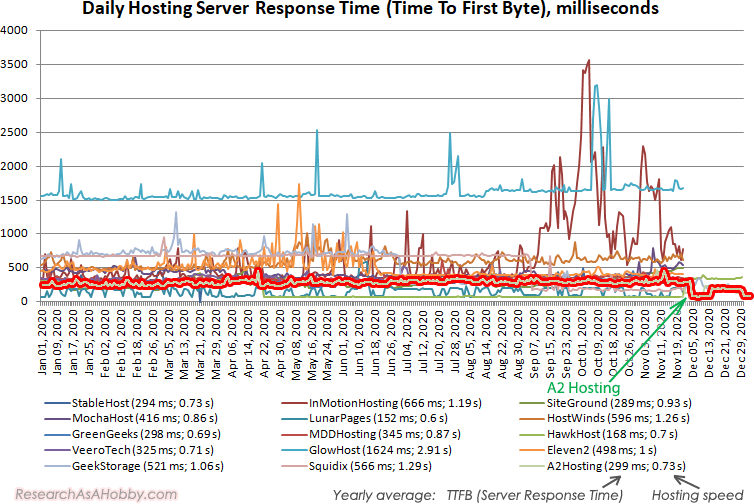
If you look at this chart, you will see that (even if you are not an expert in statistics) that Server Response Time ofA2 Hosting is one of the best compared to other hosts.
Also, it’s worth noting that A2 Hosting’s Server Response Time does not fluctuate from day to day as much as some other hosts. This is a good sign that A2 Hosting’s shared server (where my site is hosted) is managed very well.
Note that there was a sharp improvement of A2’s Server Response Time in December. In this month I moved from the cheapest Startup to Drive plan which gives nominally twice as much server resources. By the way, I made this upgrade to test several website installations in 2021 (other hosts that I continue monitoring in 2021 already allow to host more than one website).
If you look at the legend below the chart you will see that the best performing hosts do not differ much in both speed and TTFB. Also, some hosts (e.g. HawkHost) have better Server Response Time than A2, but its speed is lightly worse than A2. So, this is just a remark that better Server Response Time does not necessarily mean a better hosting speed.
I repeat it again and again that In the end speed is actually more important than Server Response Time. And here’s one more king-size chart for you: speed of A2 Hosting in comparison with other hosts (daily data displayed):
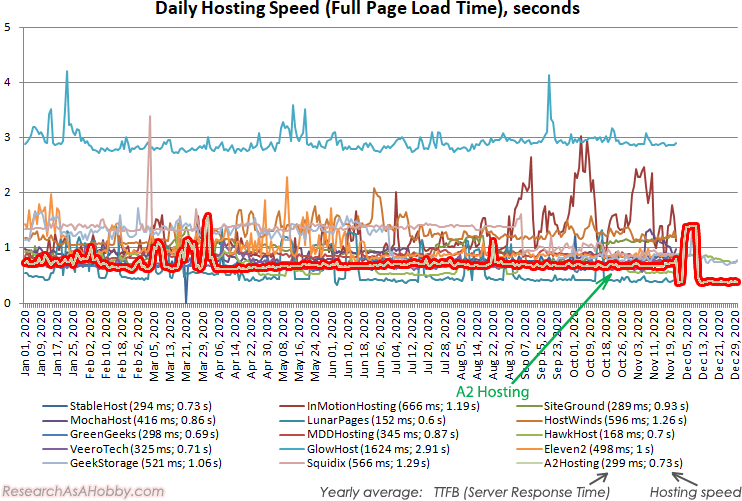
A2 Hosting had one of the best average speed (and it even improved in December when I upgraded my plan with A2 to host more than one site). Also, A2’s speed did not fluctuate much compared to some hosts. This is good.
The two charts above could be enough for a general overview. But since I’d like to look at A2’s Server Response Time data from different angles, I have more charts for you 🙂
Meanwhile, I’d like to note that superb Server Response Time and even brilliant speed are not enough to consider a hosting a great choice.
The charts with all hosts displayed in a pile do not provide some comparative details. Let’s see the analysis of A2 Hosting’s Server Response Time in comparison with other 14 hosts.
Important note: Why Server Response Time should not be used to evaluate a hosting speed
I’d like to point out that you should not use Time To First Byte (or Server Response Time) alone to estimate hosting speed from a visitor’s point of view. Since 2016 I compare TTFB and speed of the hosts using the real-life performance data (millions of tests). For example, 2016, 2018, 2019 (and the report for 2020 is not ready yet).
The main conclusion is simple: “Do NOT judge hosting speed by testing only Server Response Time”. I know that checking TTFB is much less expensive and easier, but TTFB (Server Response Time) is quite delusional metrics. Real hosting speed (technically Fulll Page Load time) is much more precise, although it’s still not 100% relevant to what your visitors may experience. But Full Page Load Time is way better than Server Response Time to estimate real hosting performance.
On the other hand, there’s a temptation to judge hosting speed because there is some connection between TTFB and final speed. But it’s a very rough estimation. From a birds’ eye view the hosts with great speed have also great Server Response Time. But however counter-intuitive it may be, it does NOT mean that the better Server Response Time guarantees a better hosting speed.
You can use, however, TTFB (Time To First Byte, Server Response Time) in addition to analyzing hosting speed to understand some particularities. For example, TTFB works the way that it ignores the size of the website (hosting speed depends on it heavily). TTFB can be also used for analyzing a particular website or server configuration (e.g. cached websites may have bigger TTFB whereas they have better speed). So, you should take Server Response Time test results cautiously. Don’t use it directly to estimating a hosting speed.
Another point that makes TTFB not reliable metrics for measuring hosting speed is that TTFB tests can be totally detached from speed. It may happen when TTFB is tested separately from speed (this is the usual way the monitoring tools test TTFB and Speed). I think I will write a separate article on that.
By the way, many other hosting reviewers test hosts once or just several times. It can give very misleading results because of unstable hosting (and/or network performance). My non-stop all-year-round monitoring does not have this disadvantage as it eliminates these risks by running hundreds and hundreds of thousands of tests for each host. You can read more about it in this article.
Also, for example, depending on whether you use caching (or CDN) solutions, TTFB (Server Response Time) can differ by multiple times depending on a particular hosting. I’ve got a detailed research on this particular topic.
At the same time, speed of hosting (which is the most important metrics after all) also depends on caching solutions. And it’s more important to test each particular host what configuration (caching, CDN) suits your particular installation, than to think stereotypically. Here’s another my research on using caching solutions on A2 Hosting.
A2 Hosting’s Server Response Time and its real-life speed compared to other hosts
I have gathered daily reports on what TTFB and speed A2 Hosting and other 14 hosts had. Then I calculated the averages and put together this chart:

The chart above shows you the disposition of the hosting real-life yearly average speed and server response time values for 2020. A2 Hosting is put at the crossing of the dashed lines (a few hosts are nearby the crossline). There are segments numbered from 1 to 4. They display the hosts which have worse or better speed and Server Response Time than A2 Hosting.
Above all, let’s see that A2 Hosting’s performance is one of the fastest among 15 hosting providers. A2 does not have the best Server Response Time (TTFB) though (it’s still good anyway). And this is totally fine. TTFB is just one of the parts that comprise a hosting speed.
Let’s see what is inside each of the sections on the chart.
The section 1 contains those hosts which are both have better Server Response Time (TTFB) and faster than A2 Hosting. Technically there are few hosts in this segment. And these hosts have very similar average speed (the difference between hosting speed is 0.13 seconds or less). At the same time Server Response Time differs by two times (compare A2 Hosting and LunarPages). It’s another argument why TTFB has not much to do with hosting speed when comparing particular hosts.
The section 2 is interesting because it contains the hosts which are slower than A2 but have better Server Response Time (TTFB). Here’s just one host which noticeable stands out – this is SiteGround. It has similar Server Response Time as A2 Hosting, but it’s a slower to some extent. Better TTFB is not always the better speed, even when judging on such a general level without diving deep in the analysis.
The section 3 is the segment with the most of the hosts. It contains the slower hosts which have worse Server Response Time (TTFB) than A2 Hosting. I’d say this is a pretty logical section as it confirms what people want to believe – sort of the better TTFB the better speed. The point is that even if it works on a general level, it’s very unreliable when you try to make conclusions on individual hosts which you have not analyzed before.
The section 4 is for the hosts which have better speed and worse Server Response Time than A2 Hosting. Technically Veerotech gets into this section, but the difference between A2 and this host regarding early average TTFB/speed is not much noticeable.
After all, there are two main takeaways from analysis of the chart:
- A2 Hosting has a great speed and very good Server Response Time recorded on average in 2020.
- On the whole, you can see the pattern that “the better Server Response Time (TTFB), the better hosting speed. But it’s true from a bird’s eye view. When you analyze the particular hosts (what you usually want to do) you need to analyze deeper. Server Response Time is absolutely not enough to judge hosting speed.
A2 Hosting’s Server Response Time compared to other hosts using histograms
In the section above there are charts to help you get a general overview of how speed and Server Response Time (TTFB) of A2 Hosting compares to other hosts. But it’s just a general overview. Let’s see more details when comparing Time To First Byte of each tested host against A2 Hosting.
Since TTFB tends to fluctuate a lot, it makes sense to use some generalized analysis like histograms. This kind of charts shows how frequent Server Response Time values get into particular ranges.
Let’s see a starting example of the histogram of A2 Hosting’s Server Response Time:
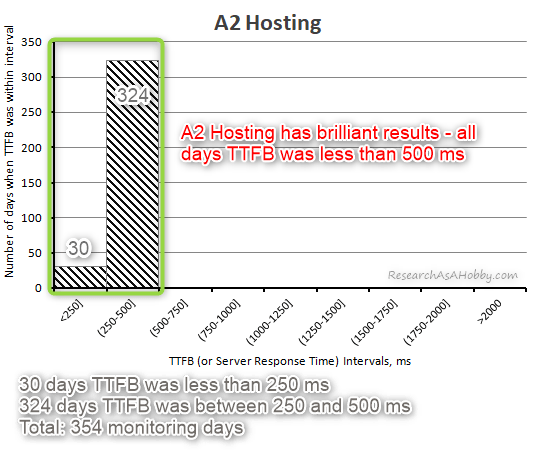
Server Response Time (Time To First Byte, TTFB) below 500 milliseconds is great. And all the TTFB values of A2 Hosting (i.e. average daily values) got into the first two intervals on the chart.
How to read the histograms for each of the hosting that I will show you below:
- The higher the bars the better – it means that the TTFB is stable throughout the year.
- But more importantly is the following: the higher bars located to the left on the charts, the better. It means there were more days with better TTFB.
Here we go!
Please keep in mind that I recommend hosts not because of their performance alone (there are many hosts with decent TTFB and speed after all). My criteria are based on researches on user stories and small hosting owners to feel the matter from different perspectives – as a client and as a person in the industry.
Is A2 Hosting’s Server Response Time good? Compare to SiteGround
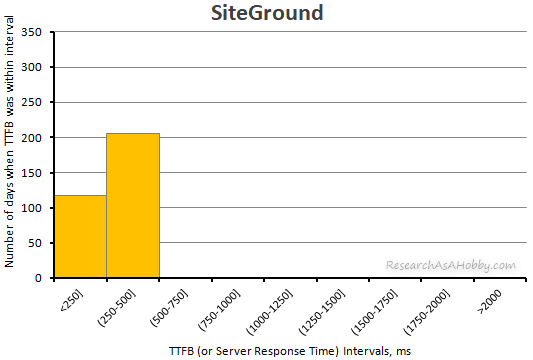
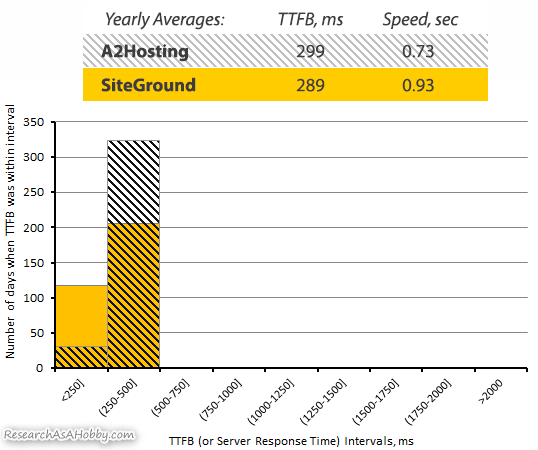
As you can see, although A2 Hosting’s Server Response Time is a little bit worse than SiteGround’s, the speed of A2 Hosting is better than of SiteGround.
In 2020 SiteGround had somewhat hard times with its service quality. But it still has not bad performance, at least on the server where my site is hosted. Many clients left SiteGround for A2 to get the attractive pricing for the first billing period.
You can read my short review on A2.
Is A2 Hosting’s Server Response Time good? Compare to GeekStorage
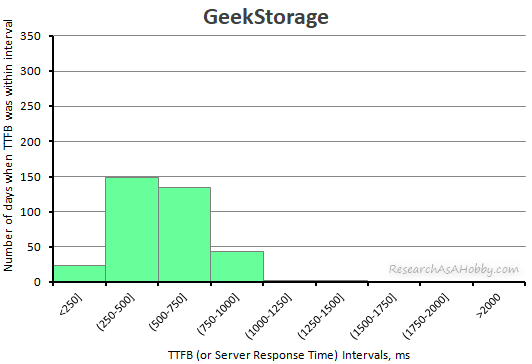
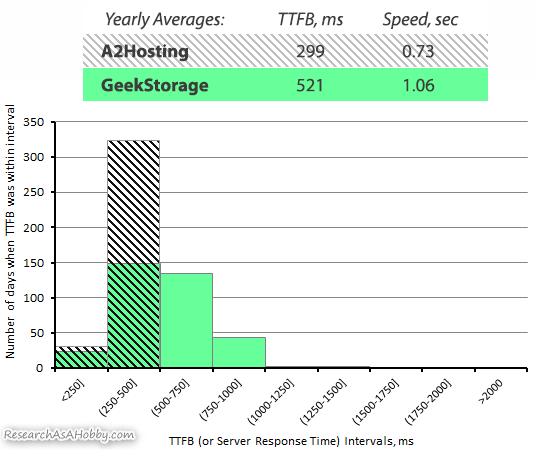
GeekStorage is one of the most affordable hosts. And still it has really good speed and TTFB. Although it was not as good as A2 during 2020.
GeekStorage is one of the hosts that I recommend (here’s my short review).
GeekStorage is not as attractive as A2 Hosting. But GeekStorage has advantage of more affordable renewal pricing.
Is A2 Hosting’s Server Response Time good? Compare to HawkHost
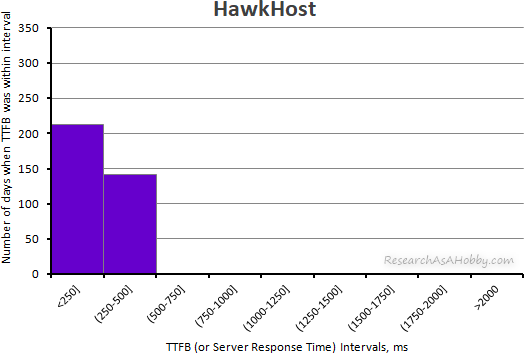
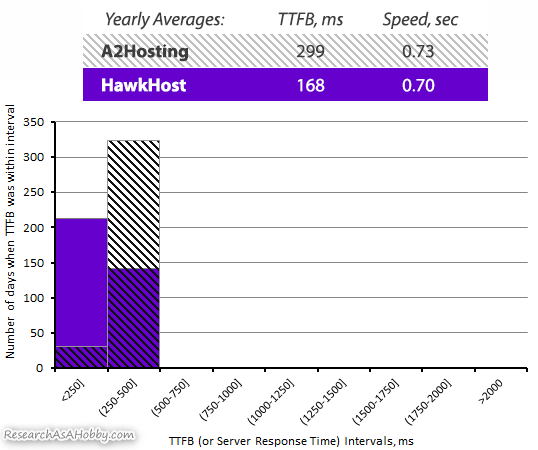
HawkHost is one of the few hosts that had better Server Response Time (TTFB) compared to A2 Hosting in 2020. Moreover, HawkHost had better speed in general. It was very good year for this host, especially considering that it’s much more affordable than A2.
I recommend HawkHost (here is my short review on it).
Of course, A2 Hosting is a bigger company and has advantages thereof (see my short review). But HawkHost is for those who want to save much and get a comparatively brilliant service.
Is A2 Hosting’s Server Response Time good? Compare to GreenGeeks
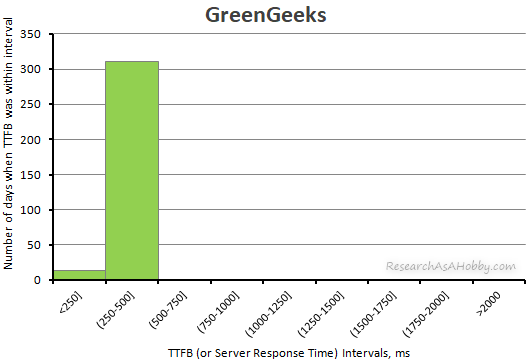
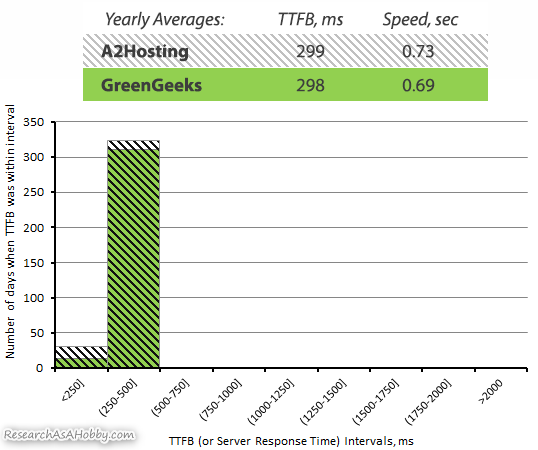
GreenGeeks has shown a very good performance results. It’s Server Response Time and speed were slightly better than A2 Hosting.
Is A2 Hosting’s Server Response Time good? Compare to MDD Hosting

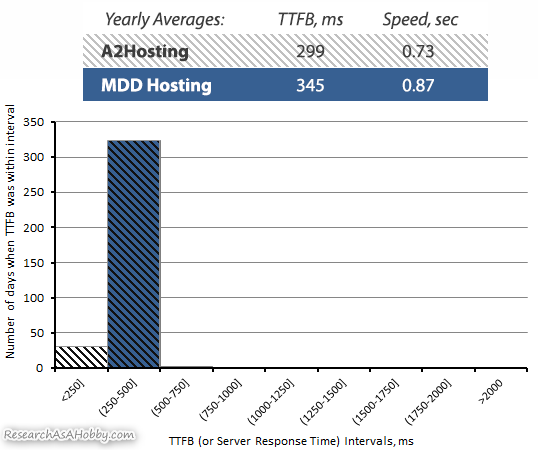
MDD Hosting had similar TTFB and speed. Yes, a little bit slower, but still great and pretty stable (all Server Response Time values got into one segment, similar to A2 though).
Although for some people MDD can be a good choice as a really small host with flexible plans, A2 is universally safer option for a bigger number of people.
Is A2 Hosting’s Server Response Time good? Compare to VeeroTech
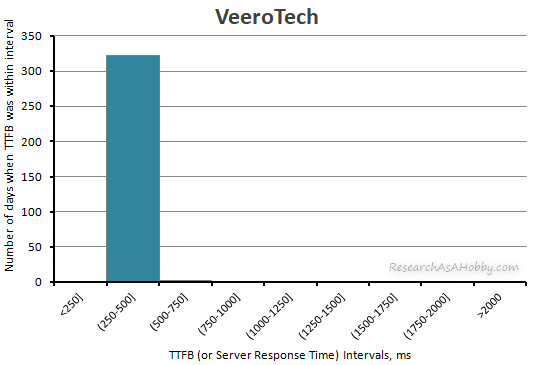
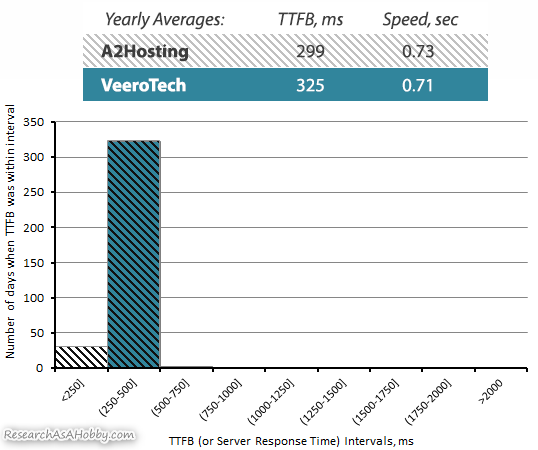
This is another example when a host (Veerotech in this case) has worse Server Response Time, but has lightly better speed than A2. Distribution of TTFB is similar to A2 Hosting in these presented segments though.
VeeroTech is not as popular as A2 (which is a bigger and more versatile host), but it has its fans (here’s a short Veerotech review).
Is A2 Hosting’s Server Response Time good? Compare to StableHost
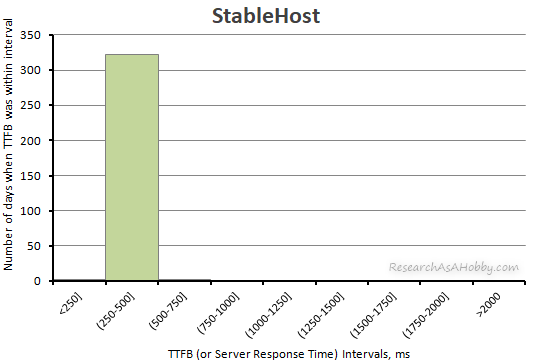
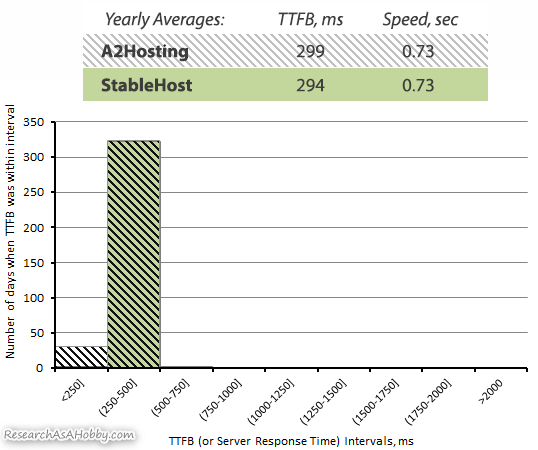
Average A2’s Server Response Time (TTFB) as well as speed values are almost identical to StableHost’s.
StableHost was acquired some time ago by MissHosting. And as we can see it did not affect its performance. Although there were claims from some clients about its support quality.
A2 Hosting or other hosts from my list are more preferable choice than StableHost, in my opinion.
Is A2 Hosting’s Server Response Time good? Compare to Squidix
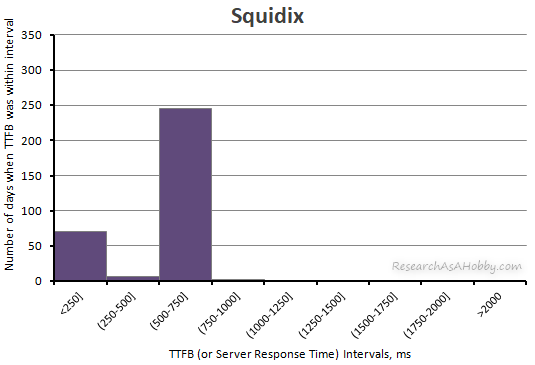
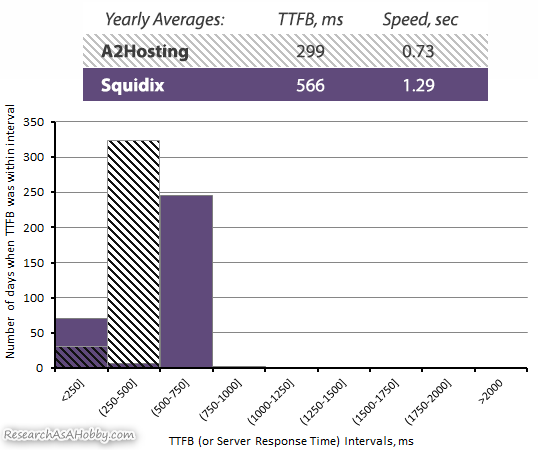
Squidix has worse Server Response Time to some extent compared to A2 Hosting. As well as its speed this is noticeably worse than A2’s. It’s interesting to note that Squidix’ TTFB is distributed withing two separate segments. It means that there was a significant change in server management (or there was something wrong with monitoring tool which is less likely because other hosts do not show this discrepancy).
Squidix’ performance is not as good as many other hosts from this research.
Is A2 Hosting’s Server Response Time good? Compare to HostWinds
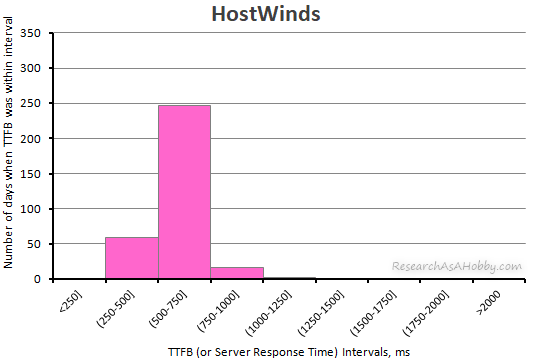
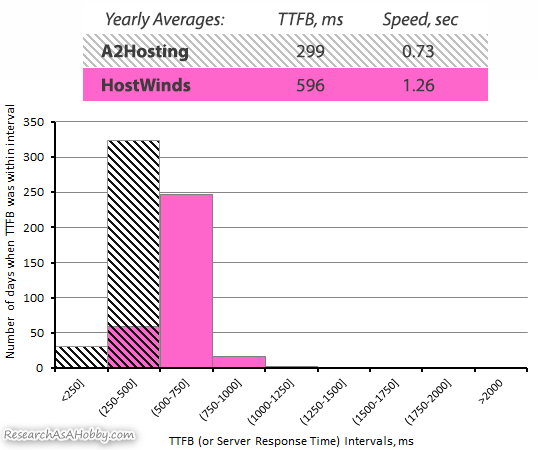
The Server Response Time and hosting speed of HostWinds is comparatively worse than the performance of A2 Hosting. And note that TTFB of Squidix (see previous section) and of HostWinds is pretty similar. But their average speed values differ quite a bit.
A2 Hosting is a more reliable option from many perspectives (here’s my short A2 Hosting review in short for additional information).
Is A2 Hosting’s Server Response Time good? Compare to LunarPages/HostPapa
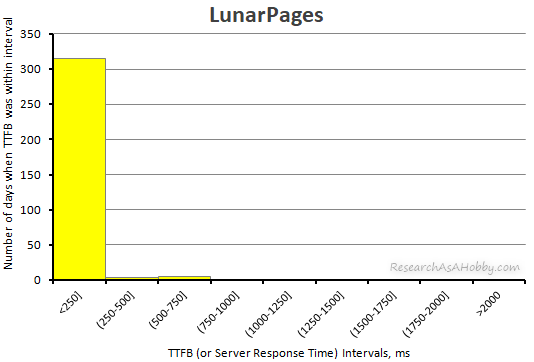
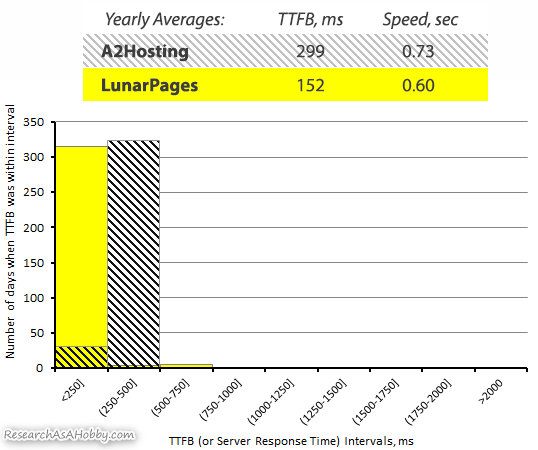
LunarPages was acquired my HostPapa and it made the speed (as well as TTFB) of this host faster in my tests. The values are even better than A2’s according to my monitoring results. The prices of HostPapa are comparable to A2’s.
If choosing between HostPapa and A2, I’d choose the latter. I just know A2 Hosting better.
Is A2 Hosting’s Server Response Time good? Compare to InMotionHosting
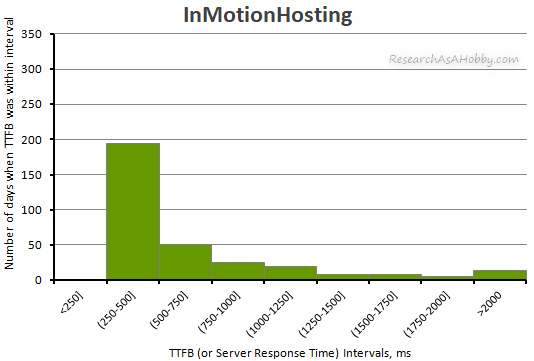
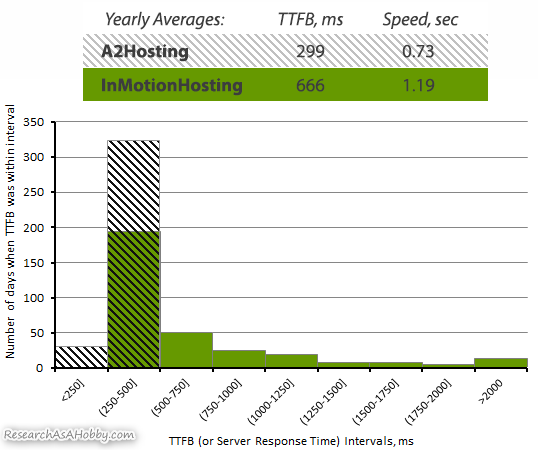
Look at the long tail of TTFB of InMotionHosting on the chart. It shows that TTFB of this host is not very stable. Although its speed is pretty good. Another argument not to judge hosting speed by Server Response Time (single tests may show bad TTDB whereas the speed is not really bad which is the most important after all).
My preference is clearly A2 Hosting, it’s a stronger option (my short A2 Hosting review).
Is A2 Hosting’s Server Response Time good? Compare to Eleven2
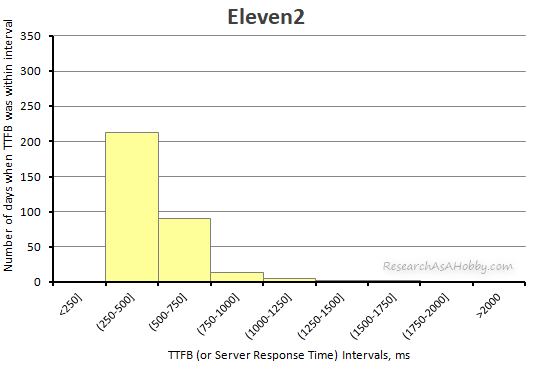
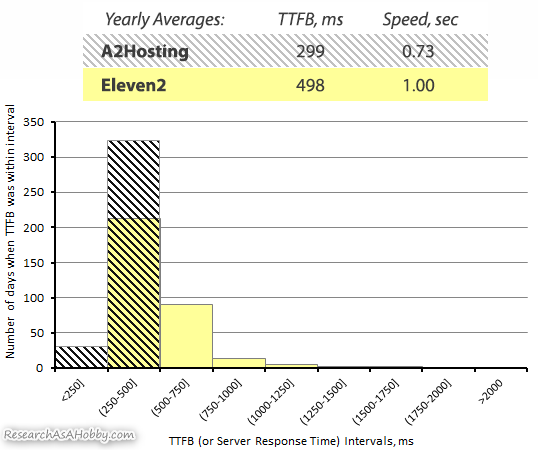
Although Eleven2 is considered to be one of the well-known shared hosts, it is not really a competitor to A2 Hosting. A2 is in a different market segment. Also, as regards technical performance, A2 has a bit better both Server Response Time and hosting speed.
Is A2 Hosting’s Server Response Time good? Compare to MochaHost
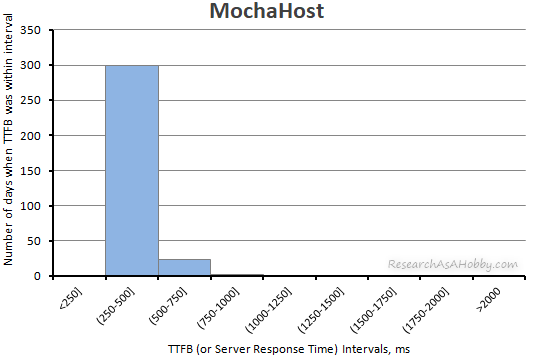

MochaHost has improved its speed dramatically since last year. And now it looks comparable to A2. Is Server Response Time is stable and the speed is great. MochaHost is known to actively buy out smaller hosts. Probably it’s the reason of not stable performance from time to time.
My preferred choice in this respect is A2 Hosting (if choosing between the two hosts).
Is A2 Hosting’s Server Response Time good? Compare to GlowHost
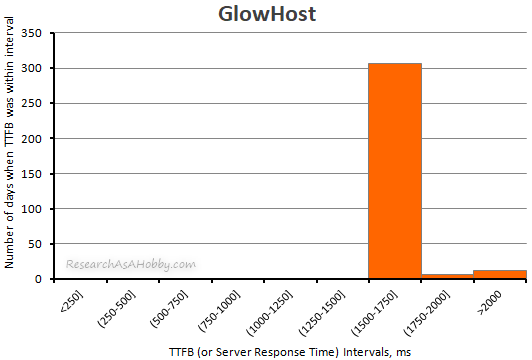
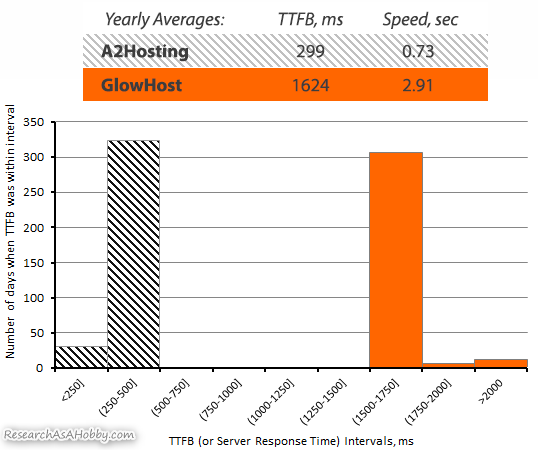
GlowHost is quite a well-known host. But compared to A2 Hosting’s both Server Response Time and hosting speed GlowHost has been awfully performing. A2 Hosting is definitely much better from performance point of view. As regards other A2 Hositng’s advantages, here’s my short review).
A2 Hosting and its Server Response Time: questions and answers
After analyzing the charts and data you still may have some questions about Server Response Time of A2 Hosting. Here are the answers to several questions about A2’s performance that people are often interested about.
Can a bad Server Response Time make A2 Hosting slow?
The following is true for any hosting, not just A2. If a host has a bad Server Response Time, then it does NOT make speed of the host automatically bad.
At the same time, bad Server Response Time CAN be a one of the reasons why hosting has awful speed. Bad TTFB (Time To First Byte or more commonly known as Server Response Time) may be the result of network issues or even your monitoring tool’s issues. Of course, these factors do not influence the hosting speed.
Anyway, if a hosting server has issues because of the server management or the core components, then bad TTFB can indicate the problems.
But how you can find out if bad TTFB results in server issues or bad hosting performance? The answer is to test TTFB and speed of hosting multiple times. It’s better if you test the performance continuously like I do. Also, testing from different locations also helps sometimes to get insights.
Since A2 Hosting is known for a great performance, it’s very unlikely that A2 will be slow because of the issues with Server Response Time. I’ve made millions of tests of A2 shared hosting server located in the USA and it reveals a brilliant performance of A2 since 2016. It regards both Server Response Time and speed (Full Page Load Time).
Anyway, if you want to check your hosting’s TTFB and speed, make sure that there are no network issues first. I.e. it makes sense to test from different locations and analyzing TTFB in each case. And of course, pay attention to a final hosting speed (you can do it even with free tools. Speed for your visitor is what matters the most after all.
Also, as a website owner or developer, you may want to improve your website speed regardless of hosting. And yes, you should focus on final speed, not TTFB. I have some articles devoted to improving website performance.
Can a good Server Response Time make the website hosted with A2 Hosting faster?
People think that better Server Response Time results in better speed. Although it’s partly true, the tricks are hidden. One of the points is that improving Server Response Time (on any host, I not talking about A2) should not be your primary aim.
Having speed in focus should be the primary aim, not trying to decrease TTFB (as I see in some articles in the web). Making Server Response time better is not the guarantee at all that your website will be faster. Sometimes it can even bring the opposite results.
This research shows brilliant performance of A2 Hosting, but can this host have a bad Server Response Time?
From a theoretical point of view, yes it can. But from practice, A2 has been proving for years to be one of the best performing hosts. It also has had great Server Response Time. I’ve been watching closely hosting performance for several years. You can read my detailed researches of Server Response Time (Time To First Byte) and comparison for the following years: 2016, 2018, 2019 (I have not published the report for 2020 yet).
I have a website hosted with A2 Hosting and I have bad Server Response Time. What should I do?
Any host actually can have comparatively bad TTFB. Network quality, location of servers, testing location (where you are or your visitors are) affect TTFB. If you use a high-quality hosting (which A2 is), the issues with bad Server Response Time are not very likely. But anyway, in case you meet the issues with A2 or other hosts here what I can suggest:
- If your website is as fast as you expect it, then simply don’t pay attention to Server Response Time (or TTFB, because in many ways it’s meaningless). There are many reasons why TTFB may be not as good as you probably would want it. But speed may be fine (and you don’t need anything else!).
- If you experience slow website, then it does not make sense to blame Server Response Time. Because first of all you need to find out the true problem. TTFB is not what you should be concerned about as a web hosting client. But what you can do is optimizing your website (I know this is a huge topic). Or simply switch a host. Sometimes there are conflicts with server configuration and your software. In this case it’s simpler to move to another hosting (of course, if hosting support can’t fix the issue).
- If you have solid arguments that Server Response Time makes your website slow, then here are some steps to try:
- Check TTFB without using database or scripts on a server side. In other words, create a simple HTML page which does not make database requests (a pure HTML page). Also, create another page with database requests (e.g. install a default WordPress site). Make sure you don’t have any caching solutions used (e.g. plugins or CDN).
- Test Server Response Time (TTFB) of a pure HTML page. This result will exclude any influence of the database. This way you get a better understanding of your actual Server Response Time. And when you test TTFB of your default WordPress site, you get the results which include database access time. If you compare the test results with the previous testing, you can get some insights about the issues with the database latency.
- Do numerous tests of TTFB (the more, the better, but at least not less than 3). If you do very little tests, it’s likely that your insights may be misleading. The reason is that Server Response Time test results may fluctuate quite a bit (read my research about this topic).
- Analyze Server Response Time (TTFB) test results. If you see that numerous tests of the pure HTML page give okay TTFB, then the problem of your slow website is not connected with Server Response Time. IF TTFB is bad, then the issue may be rooting at the server level, as well as somewhere between the testing location and the server (e.g. network issues, DNS problems). Do several tests from different world locations and in different time, it can give you additional insights.
Conclusion
Time To First Byte (TTFB), or Server Response Time, is a technical term. Due to some buzz on the web, it acquired some attention of not technical website owners. And ordinary hosting clients (including A2 Hosting’s clients), believe that TTFB should be as little as possible. As if it makes the requests to the server faster. In this simple interpretation this assumption is false. Partly it makes sense to be concerned about TTFB, but not in that straightforward way.
In short, as I’ve already mentioned several times in this article, Time To First Byte or Server Response Time is not really important. But speed is. Yes, TTFB is a part of the hosting speed. But improving TTFB is NOT the right way to make website faster. Also, although there is some correlation that the better TTFB the better hosting speed, you should not rely on it blindly.
Some hosts may have better speed but worse TTFB (this is applicable to A2 Hosting too). Moreover, TTFB of a hosting may change within some time, whereas its speed does not change much.
Also, hosts may have similar TTFB but quite different speed. As well as hosts may have similar speed but different TTFB. A2 Hosting demonstrates great TTFB (although A2’s TTFB is not the very best among the 15 tested hosts). As regards speed, A2 is one of the top winners. Speed matters the most.
P.S.: I recommend A2 Hosting above all other hosts as a universal hosting option (although there are other superb hosts if you have specific preferences). To be honest, I don’t rely on TTFB when evaluating hosts. Speed does matter, TTFB does not. Also, I mention things to consider when choosing A2 in my short review of this host.

BTW, I respect your privacy, and of course I don't send spam, affiliate offers or trade your emails. What I send is information that I consider useful.




Hey! Michael
The way of your writing is too good, even on the behalf of A2 performance it’s pretty much good. Keep going, bro
Too good is a good reason to keep going, Harshit, yeah 🙂 Feel free to ask any questions!
Hey Michael,
Your graphical presentation with the explored article was so good. At the same time performance of A2 is pretty good.
Thanks, Mark, I tried hard 🙂
Hey Michael,
A2 Hosting Has Good Server Response Time compare to other hosting I thanks for denoting here. too knew the performance and speed of A2 hosting. Thanks for denoting here.
Yeah, performance of A2 is pretty good.